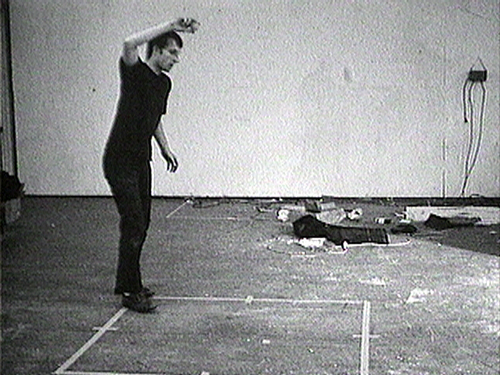Newly launched by ADHT’s Insights Magazine, Notices is a multi-part series which features reviews and commentaries produced by students currently enrolled in one or more of the school’s ongoing semester courses. Migrating images, ideas, and conversations in and out of the Parsons community everyday, students offer a way of seeing and engaging with multiple worlds at the same time. Their education–rather than being limited to the classroom–is diffusive and fluid, their curiosity, roaming and magnetic.
The second installment can be found below. Click here for the first.
A Studio in Which to Act
Review. A World of Its Own: Photographic Practices in the Studio
Recently on view at The Museum of Modern Art, February 8–November 2, 2014
by Vita Brown
As the first MoMA show curated by new chief curator Quentin Bajac, A World of Its Own: Photographic Practices in the Studio recently encompassed six rooms in the museum’s photography wing. Investigating the ways in which artists have used and experimented within their studios, the show highlighted the diversity of studio practices. In the wide variety of work displayed, the most compelling aspect of the show came through in its video work, specifically the films “The Way Things Go” by Peter Fischli and David Weiss, “Bouncing Two Balls between the Floor and Ceiling with Changing Rhythms” by Bruce Nauman, and the short videos by Roman Signer.
The three videos show their respective artists working in their studios, all taking vastly different approaches. “The Way Things Go,” produced in 1987, is a thirty-one-minute-long 16mm film that shows objects as they topple, burst, burn, twist, and smoke, producing a continuous chain reaction. At first glance it appears to be a single take, but upon closer look, it becomes clear there the piece is composed of a number of fluid cuts that allow it to run smoothly. The video, created by Swiss artistic duo Peter Fischli and the late David Weiss, whose work showed a sense of humour and a flare for turning the ordinary into something new and unexpected, seemed to be the highlight of the show, as the 100-foot installation never failed to transfix the crowd of spectators. The majority of the objects used are highly industrial–e.g. tires, fuses, and lethal liquids–and the marvel of the video lies in the innovation with which the artists have used these materials. The piece is an exploration into the world of industry, a topic that retains social significance today because of the widespread climate issues created in the wake of industrial excess.
Roman Signer, another Swiss artist and an inspiration to Fischli and Weiss, is a multi-media artist who works with sculpture, installations, photography, video, and performance art. His videos, much like Fischli and Weiss’s, also have comedic elements, but appear in a much more muted way. At MoMA, two televisions–displaying a total of 18 videos produced from 1975 to 1989 and shot with Super 8–showed him making “action sculptures,” or depictions of him setting up, executing, and recording experiments. Though 18 two-minute videos could have seemed excessive for an exhibit of the size, the captivating quality of his work made time seem to disappear, freezing the viewer in place for the entire duration of his works. The videos depicted a number of manipulated events, from a bucket full of water swinging back of forth to a fan spraying sand on the floor to Signer cycling around four columns with tape. The interest of these videos came from the juxtaposition between the banality of these experiments and the beautiful and intriguing results yielded. The viewer also felt a sense of excitement from Signer’s seeming uncertainty toward the outcome of these events.
Though Nauman’s 1967-68 “Bouncing Two Balls…” was the last film displayed at the exhibit, it was the earliest made, highlighting that the show’s strain was thematic, rather than chronological. This organizational scheme worked well with Nauman’s video, a ten minute long 16mm film that shows him doing exactly as the title suggests in his messy studio, offering a strong continuation from the Fischli and Weiss and Signer pieces. Looked at together, the three works show a progressive delineation of structure and order, with the first having great control, the second depicting controlled chance, and the third being mostly unplanned. Choice of medium is always essential to Nauman’s work, and in the case of ‘Bouncing Two Balls…’ the use of video allows the viewer to take in the performance aspect of the work, to understand just how happenstance the bouncing of the ball is. Given its particular length, the video makes apparent the passage of time as something continuous and redundant rather than linearly narrative.
Though all three works were independently made, their striking similarities were bought to the foreground in the curatorial decisions. With “The Way Things Go” and Signer’s short videos being shown almost side-by-side, Signer’s influence on Fischli and Weiss was evident: the latter’s piece was arguably an extended version of the former’s shorts. With Nauman on the other side, the show highlighted the autonomy of the studio space, as well as its flexibility in adapting to what events occur within it.
In a space like MoMA, it is incredibly easy to leave one room in favour for the next. Still, A World of Its Own: Photographic Practices in the Studio managed to hold its own ground, with its eclectic array of studio work and wonderful photographic and video pieces. One wishes that the checklist had included some contemporary pieces, as the three most compelling video pieces are exemplary of the way a studio can be stretched, pushed, and pulled to become such a malleable space in time.
——————————————————————————————————————
Vita Brown is currently studying Photography at Parsons The New School for Design. Originally from London, she moved to New York just over three years ago to pursue her passion for art. She is currently studying with ADHT’s Margot Bouman.




























